We are, it’s often said, a nation of animal lovers. The beauty of our native wild birds, in particular, is celebrated in word and art, in print and on screen. However, there are some prominent species that don’t attract universal adoration, and it is the gulls that top of that list.
Is there any more divisive wild bird in the UK than the herring gull? This is the default ‘seagull’ of our coastal towns, the silver-backed and yellow-billed, bright-eyed and raucous-voiced scourge of many a beach picnic, and despoiler of many a parked car.
Yet we admire its grace on the wing, and we can’t help but admire its intelligence, which becomes more apparent year on year as we learn more about its ways (see below). We coo over its cute, fluffy offspring, and we might even find its squawks delightfully evocative (from a distance). The British seaside would certainly not be the same without it.
Read on to learn more about the different gull species in the UK by birdwatcher and author Marianne Taylor:
How to watch gulls
Gull-watching won’t always take you to the most enchanting wild places – there is great gull-watching to be had at rubbish dumps, for example, and smelly fishing ports. But the exciting possibility of finding something unusual within the swirling, screaming flocks is magical enough.
Even seaside towns turn up their share of unusual species, as well as providing great close-up opportunities to watch the commoner species interacting, and to look out for individuals wearing numbered DARVIC leg-rings, as part of various research projects studying gulls’ seasonal movements and lifespans.
Please note that external videos may contain ads:
A Seagulls Unbelievable Eyesight | Nature's Boldest Thieves. © BBC Earth Unplugged
For birdwatchers, the herring gull and its relatives are also divisive, for a different reason. Large gulls take four years to reach adult plumage and on the way there they pass through various intermediate immature stages that can be very difficult to identify, especially given considerable individual variation.
Throw the chance of a rare vagrant species into the mix, and the ‘sorting out’ of a flock of mixed-aged gulls becomes a challenge that may excite or terrify a birdwatcher, depending on your outlook. There are many who love gull-watching so much that they define themselves by this passion, as a particular subcategory of birders – they’re ‘gullers’, or a more high-brow alternative is ‘larophiles’ (after Laridae, the gull family).
Why do some gulls stamp on the ground?
At least three of our breeding gull species – herring, black-headed and common – have been pictured stamping lightly on the ground. Known as ‘paddling’, this behaviour tends to be seen on soft terrain, such as wet sand or mud, and draws prey such as worms, amphipods and other invertebrates to the surface. The paddling action is thought to mimic the vibrations of falling raindrops, which ordinarily lure the creatures upwards.
Q&A answered by Mike Toms.
How many eggs do gulls lay?
These birds are loyal partners and protective parents. Some species nest in very close-knit colonies, though reunite with the same mate year after year. They are nest-builders, using whatever vegetation is handy to pile up a large, untidy nest on a flat surface. Most gulls will produce two to four eggs, and they will have only one brood each year.
Depending on the nest’s surroundings, the chicks (which are semi-precocial – able to move well soon after hatching but needing to be fed by their parents) will start exploring more widely away from the nest at a few days old, but when a parent with a full crop shows up, it will race over and beg to be fed with squealing calls, pecking at the adult’s bill (specifically, at the red bill spot in the case of the large gulls). After enduring this harassment for a little while, the adult will regurgitate whatever it has swallowed, for the chicks to eat.
Young gulls will not usually breed until at least two years old (older in larger species). They spend their adolescence living in groups, learning from one another, engaging in play behaviours as well as foraging, and wandering around in search of possible places to nest when the time comes – many will go on to breed at the same site where they were reared, but new colonies are also established where conditions are suitable.
How gulls have adapted to humans
If you watch gulls for a while, you’ll observe all kinds of different and innovative behaviour. You might notice gulls on playing fields performing a foot-drumming dance – this mimics falling rain and can trick earthworms to move to the surface.
Gulls deal with hard-shelled molluscs by lifting them high into the air and dropping them on to rocks. And many of us have seen the viral video of a gull sidling into a branch of Greggs, snatching a bag of crisps from a low shelf and running back out – it dealt with this potentially tricky food by holding the bag down with its feet as it tore open the plastic.
Living alongside the human species is difficult for most wild animals, but some adaptable species can do so very effectively, and that includes some of the gulls. Their natural way of life – nesting on a clifftop, foraging at sea and along the strandline – still works perfectly well where those habitats exist, but humans have colonised long stretches of coast today. However, this provides new places for gulls to breed and new ways for them to feed, and these intelligent birds always have their eyes open for opportunities.
Please note that external videos may contain ads:
Does the Colour of Food Prevent a Seagull from Stealing? © BBC Earth
We are beginning to learn that gulls’ behaviour in towns goes beyond using our buildings as substitute clifftops, and our streets and landfills as substitute strandlines – gulls pay attention to us, too. In some seaside towns (St Ives in Cornwall springs to mind) the herring gulls know no fear and will fly into your face and seize your pasty from your hand as you raise it to your mouth. However, some studies have found that you can discourage a scrounging gull by maintaining eye contact with it as you eat.
Gulls also observe and learn about human behavioural patterns. Researchers at the University of Bristol fitted a dozen lesser black-backed gulls with GPS trackers to monitor their daily routine. They found that the gulls had learned the routines of local humans and planned their own day accordingly. They gathered at a school playground in time to scavenge scraps dropped by the children while they were out on their morning and lunchtime breaks, and visited a waste centre only at the times (and days) when lorries were coming in with food waste. Read the full paper in IBIS (the international journal of avian science).
Are gulls endangered?
Gulls sometimes annoy us, with their scavenging ways, loud voices and assertive personalities. Yet they are in trouble – all of our breeding species are on the UK list of Species of Conservation Concern and two (kittiwake and herring gull) are Red-listed, because of serious recent declines.
It comes as a shock to many birders that herring gulls, which seem so tough and streetwise and such consummate survivors, should be in such dire straits, but even they are not immune to the huge ecological changes that have affected our seas and coasts over the last few hundred years, and the last few decades in particular. A little tolerance to the small proportion of their population that is managing (for now) to survive and thrive in our towns could go a long way.
Which gull species are found in the UK?
Most of the world’s gull species breed on coasts in the northern hemisphere and many will wander long distances across land and sea at times, which makes the UK a great place for seekers of rare gull species.
There are 25 species of gulls on the British list, which is almost half of the entire world list. Our tally includes rarities that have strayed our way from the Arctic circle, eastern Asia, the Mediterranean, and the USA. However, the list of species that breeds here is much shorter:
Herring gull (Larus argentatus)
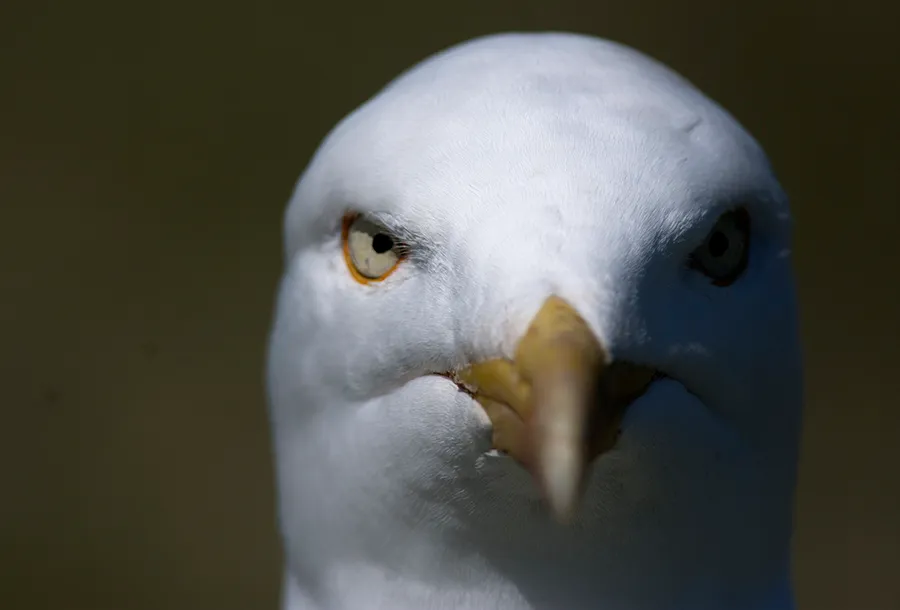
- UK breeding population: 140,000 pairs
- UK winter population: 740,000 birds
- Conservation status: Red
This is the most familiar of our gulls, as it nests on rooftops in seaside towns (and, increasingly, inland too). However, most of our breeding population still nests in wilder coastal areas. In winter many move inland and visit inland reservoirs, fields and landfill sites. Adults have light silver wings and back, with black, white-spotted wingtips. The legs are pink, the eyes pale yellow with a yellow ring of skin around them, and, as with our other large gulls, the bill is yellow with a red spot. In winter, adults develop some grey streaking on the head and neck.
Lesser black-backed gull (Larus fuscus)
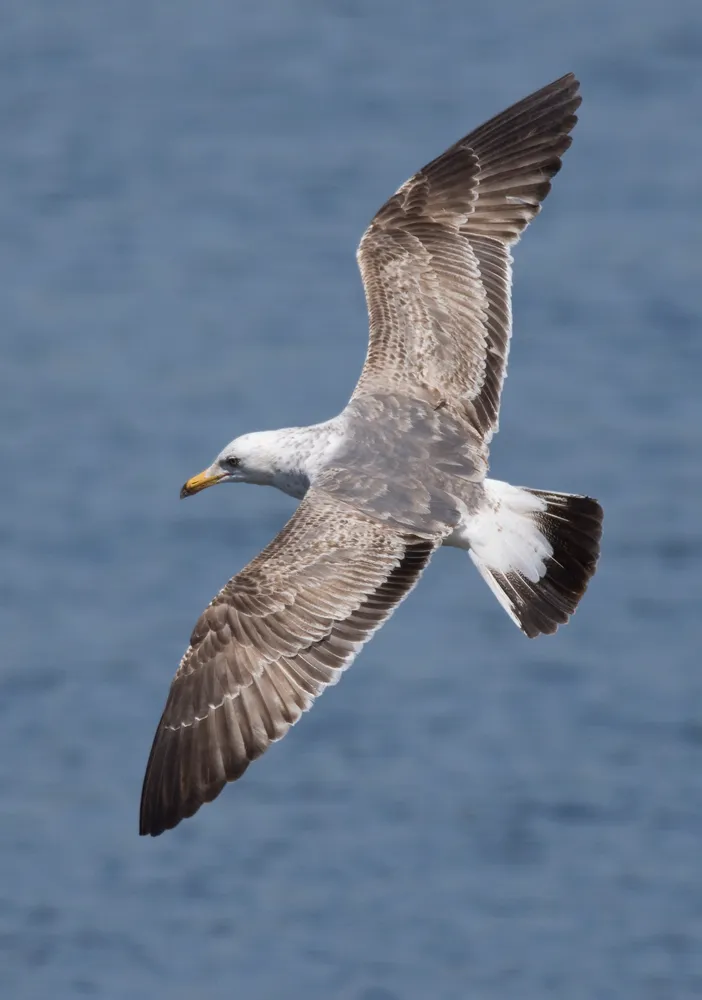
- UK breeding population: 110,000 pairs
- UK winter population: 130,000 birds
- Conservation status: Amber
The lesser black-backed gull generally nests inland or on low-lying coastal islands. It is also common inland in winter, though many of our breeding birds move south out of the UK in winter. It is about the size of a herring gull and generally similar in appearance. But is slimmer and longer-winged. It has dark grey wings and back, which contrast with the black, white-spotted wingtips. The legs are yellow, and the eye-ring is red; the adult’s winter head has more dark streaking than the herring gull’s does.
Great black-backed gull (Larus marinus)

- UK breeding population: 17,000 pairs
- UK winter population: 76,000 birds
- Conservation status: Amber
This bruiser of a bird is the world’s largest gull. Seen next to a lesser black-back, it is much bigger but also proportionately shorter-winged, bigger-billed, and looks barrel-shaped in flight. Its back and wings are almost jet black, not contrasting with the black, white-spotted wingtips. The legs are pink, and the rather small-looking eyes are darker and greyer than in the other larger gulls. The head remains very white in winter. Great black-backs nest mainly on rocky, remote coasts, and are relatively rare inland, even in winter.
Yellow-legged gull (Larus michahellis)
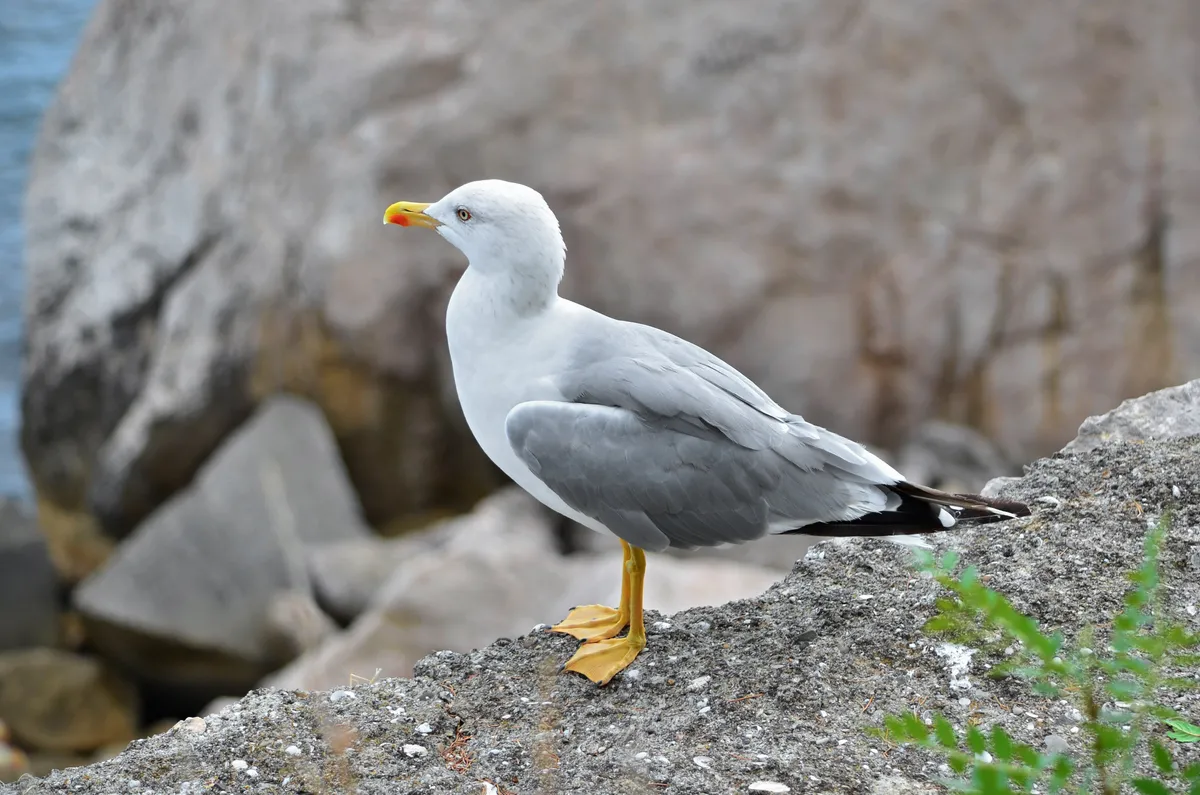
- UK breeding population: 1–4 pairs
- UK winter population: 1,100 birds
- Conservation status: Amber
This gull’s shade of grey is in between that of herring gull and lesser black-back. It is closer to herring gull or even a small great black-back in build, being robust and hefty with relatively short wings. The legs are yellow and the eye-ring red, and the winter head has very little grey streaking. This is the commonest seaside gull in Mediterranean Europe but has only a very small breeding population in the UK, though it becomes more numerous in winter, especially in the south.
Common gull (Larus canus)
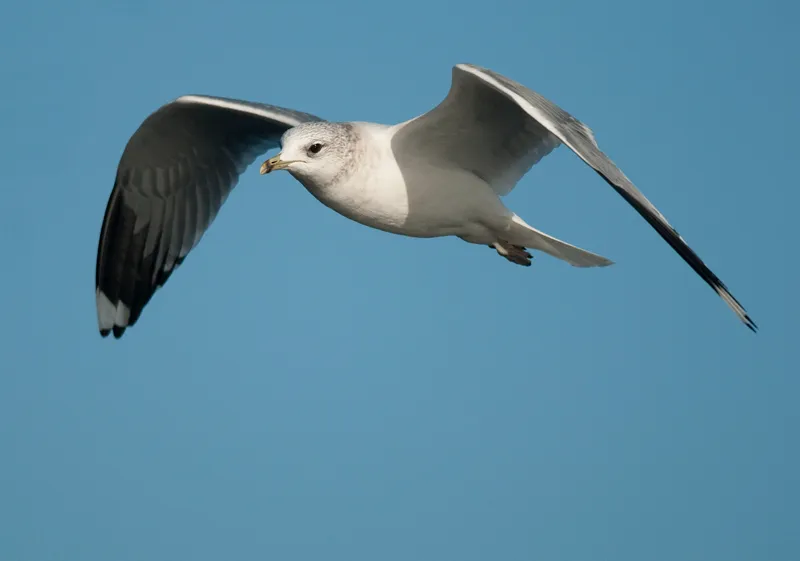
- UK breeding population: 49,000 pairs
- UK winter population: 710,000 birds
- Conservation status: Amber
The common gull is markedly smaller than the previous four species, though not as small as a black-headed gull, and has a distinctly gentler and less menacing look. Its build is slim and graceful with proportionately long wings. It has mid-grey wings and back with white spots in its black wingtips. The eyes are dark, the bill yellow with no red spot, and the legs are dull greenish. In winter it develops copious fine grey streaking on the head and neck, and a dark ring appears near the tip of the bill.
Common gulls nest inland, many of them around lochs and stony rivers in Scotland. Despite the name, this is the second rarest of our six widespread breeding gull species (its name may relate to its fondness for foraging on fields or ‘commons’, rather than its abundance), but it becomes more numerous and very widespread, both inland and at the coast, in winter.
Kittiwake (Rissa tridactyla)
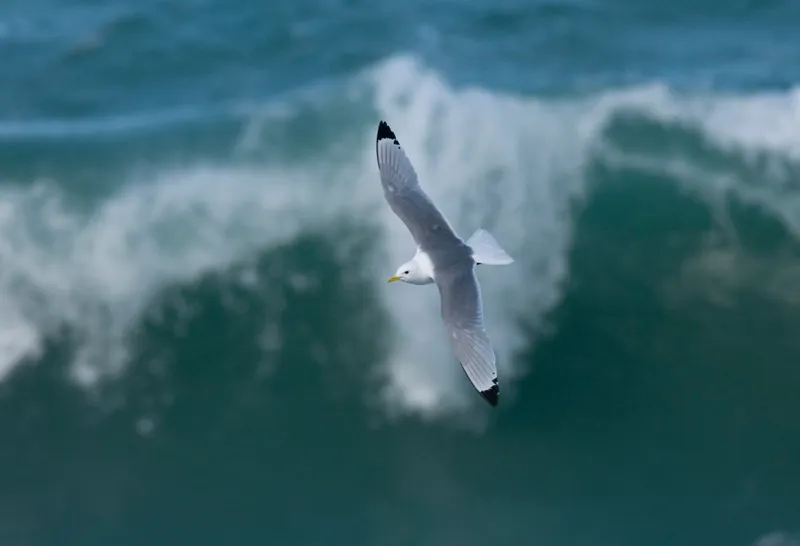
- UK breeding population: 380,000 pairs
- UK winter population: spends winter out at sea
- Conservation status: Red
This gull looks, at first glance, a lot like the common gull, being similar-sized, and having mid-grey back and wings, dark eyes and a yellow bill. However, its legs are black, and strikingly short, and its wingtips are solid black without dark spots. In winter the differences increase, with kittiwakes developing a dusky grey ‘shawl’ on the neck, and a smudgy dark spot behind the eye.
Please note that external videos may contain ads:
Seagulls and Guillemots Working Together to Fish. © BBC Earth
This gull nests on steep sea cliffs (or occasionally on coastal buildings), often among guillemots and other cliff-nesting seabirds. Its colonies are concentrated in the north of the UK and it is by far our most numerous breeding gull.
However, it spends its winter roaming out at sea, and is rarely seen inland at any time of year.
Mediterranean gull (Ichthyaetus melanocephalus)
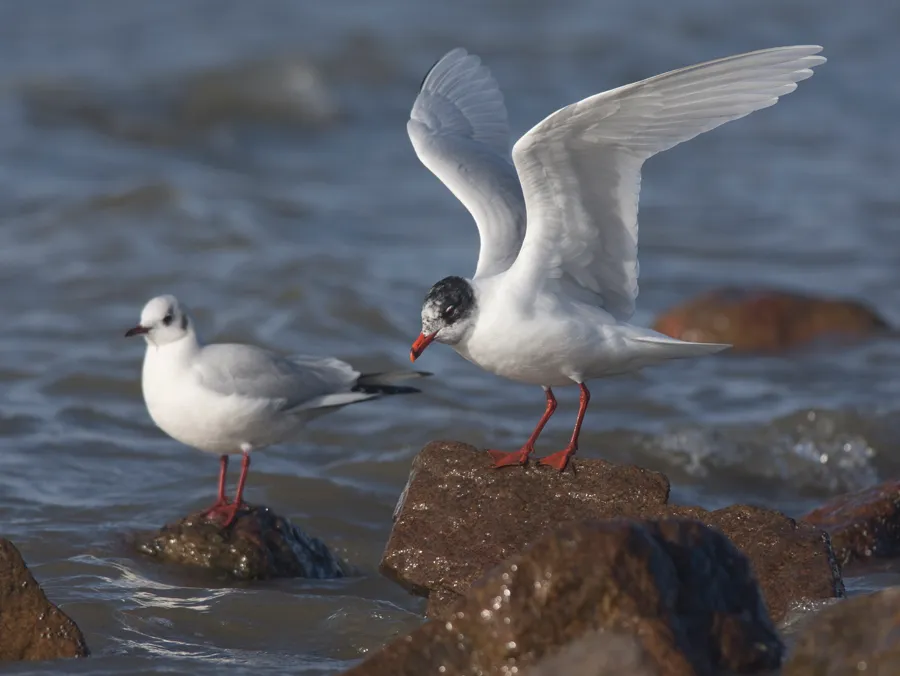
- UK breeding population: 630 pairs
- UK winter population: 1,800 birds
- Conservation status: Amber
Since the 1950s, the Mediterranean gull has been nesting in increasing numbers in the UK, mainly among nesting black-headed gulls, where it dominates the smaller species, and often draws attention with its distinctive querulous call. It is commonest in the south. In winter, Mediterranean gulls from north-eastern Europe and beyond come to the UK, mainly visiting coastal sites. The wings and back are very pale grey, the wingtips pure white, and when breeding it sports an extensive, solid black hood, contrasting with its bright red bill. The legs are also red. In the winter the hood is reduced to a slight blackish mask around the eye.
Black-headed gull (Chroicocephalus ridibundus)
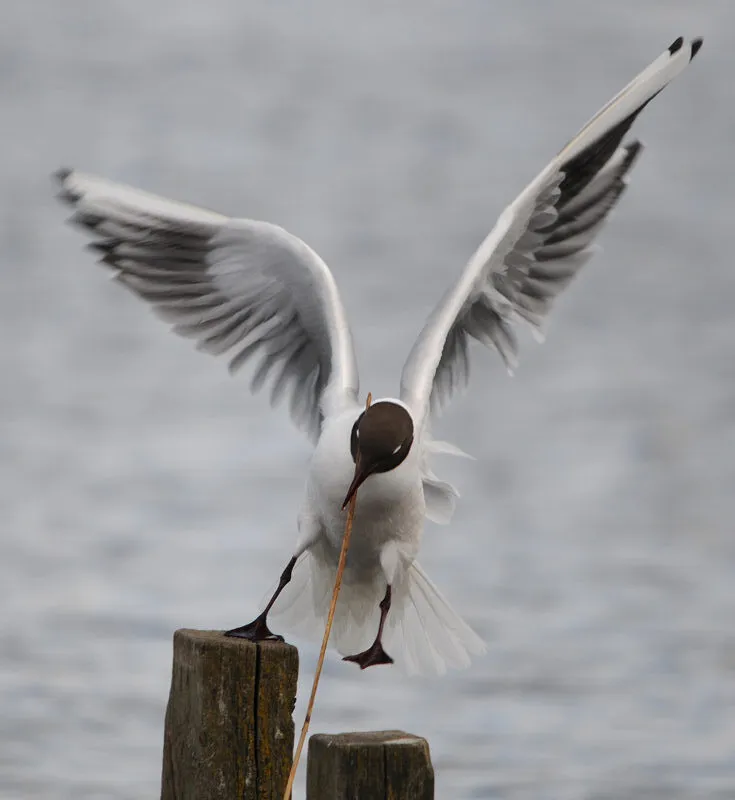
- UK breeding population: 140,000 pairs
- UK winter population: 2,200,000 birds
- Conservation status: Amber
This is our smallest regularly breeding gull. It is a little larger than a pigeon, and has light silver grey wings and back. The outer part of the wing shows a white leading edge and black trailing edge in flight. In breeding plumage it has a dark brown hood, ‘cut high’ on the nape, and the bill is blackish, the legs red. After breeding, the bill becomes redder, and it loses its hood except for a neat blackish spot behind the eye. Most breeding colonies are on marshy wetlands near the coast, but some are further inland. In winter it is widespread at the coast and inland.
Which other gulls can be seen in the British Isles?
The rarer gulls that turn up regularly here (albeit in small numbers) include glaucous gull (a large, pale bruiser from the Arctic); Iceland gull (a smaller version of the glaucous gull); Caspian gull (a relative of the herring gull, from eastern Europe and western Asia); little gull (the world’s smallest gull, breeding in north-eastern Europe and further east, but migrating westwards for winter); and Sabine’s gull (an Arctic species and long-distance migrant which is regularly seen from our south-western coasts in autumn, and is sometimes storm-driven inland).
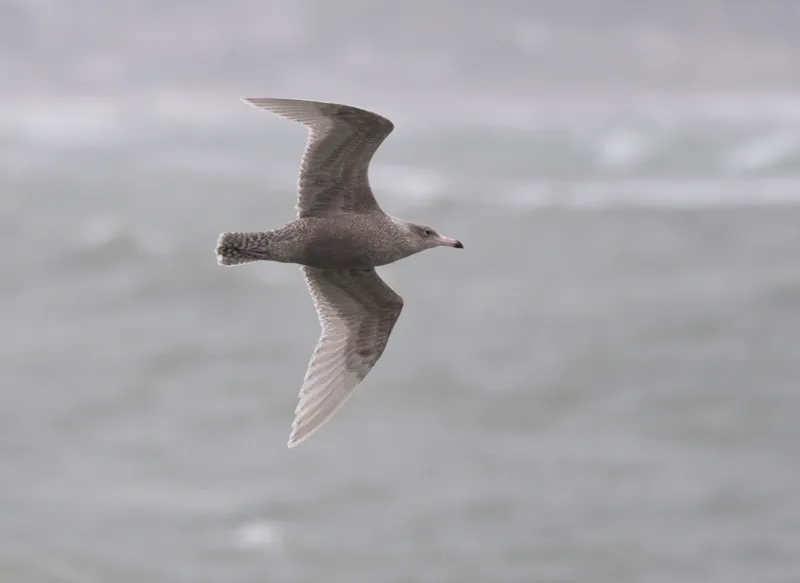
Several North American species are on the British list, of which the most frequent visitors are laughing gull (like a larger, darker, more doleful-looking black-headed gull) and ring-billed gull (a halfway-house in size and appearance between common gull and herring gull). It is common for a particular individual rare gull to stay around for months, and to visit year after year – gulls are creatures of habit and they have long lifespans, with several larger species known to live into their thirties.

Gulls are, in some ways, the seaside equivalent of the crows, being medium to large in size, and clever and adaptable in nature. All gulls have webbed feet and are comfortable enough swimming on the surface, but not underwater. They run quickly for web-footed birds, and have strong and reasonably agile flight – their agility is most often put to use trying to chase down other gulls that have picked up some food. They eat pretty much anything that will fit in their throats and the larger species can be quite predatory, opportunistically hunting small mammals and baby wildfowl as well as fish and other water life.
Are skuas, terns and fulmars types of gull?
No, there are actually several other birds that you may see at the coast that could be mistaken for gulls.
Skuas (Stercorarius sp.)
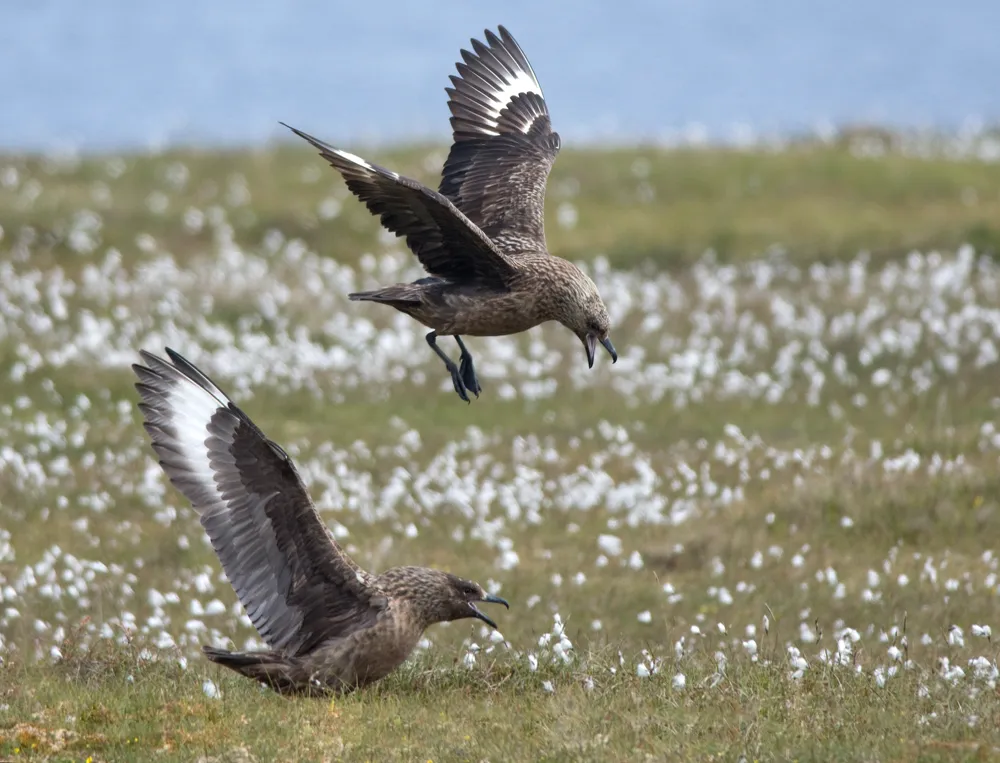
Adult skuas of the smaller species are distinctive, with their elongated central tail feathers. However, young small skuas, and the great skua at all ages, are mottled brown and could be confused with juvenile gulls. Look out for the white flashes in their wings, and their agile flight as they chase other seabirds, trying to steal food from them.
Terns (Sterninae subfamily)
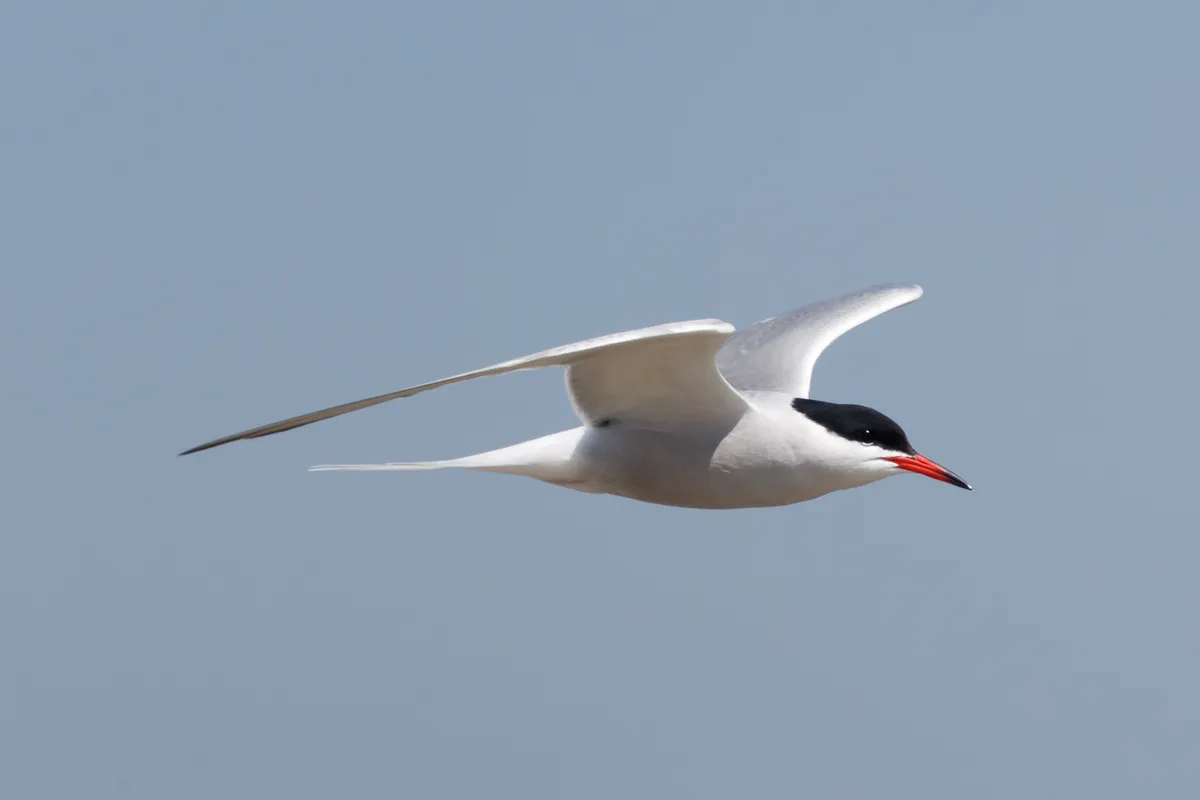
There are five species of ‘sea terns’ which are summer visitors to the UK. They are smaller than most gulls with long, narrow wings, long sharp bills, and very agile flight – they mainly feed either by picking scraps from the water’s surface on the wing, or by plunge-diving. Adults in breeding plumage have black caps but not complete black hoods.
Fulmar (Fulmarus sp.)

This cliff-nesting bird looks gull-like with its white body and grey wings, but is a type of petrel. It looks a little front-heavy with a proportionately big head. It has a distinctive flight, alternating gliding and fast flapping and holds its wings very straight and stiff. With a closer view, look for its large dark eyes and the tubular nostrils on its bill.
Northern gannet (Morus bassanus)
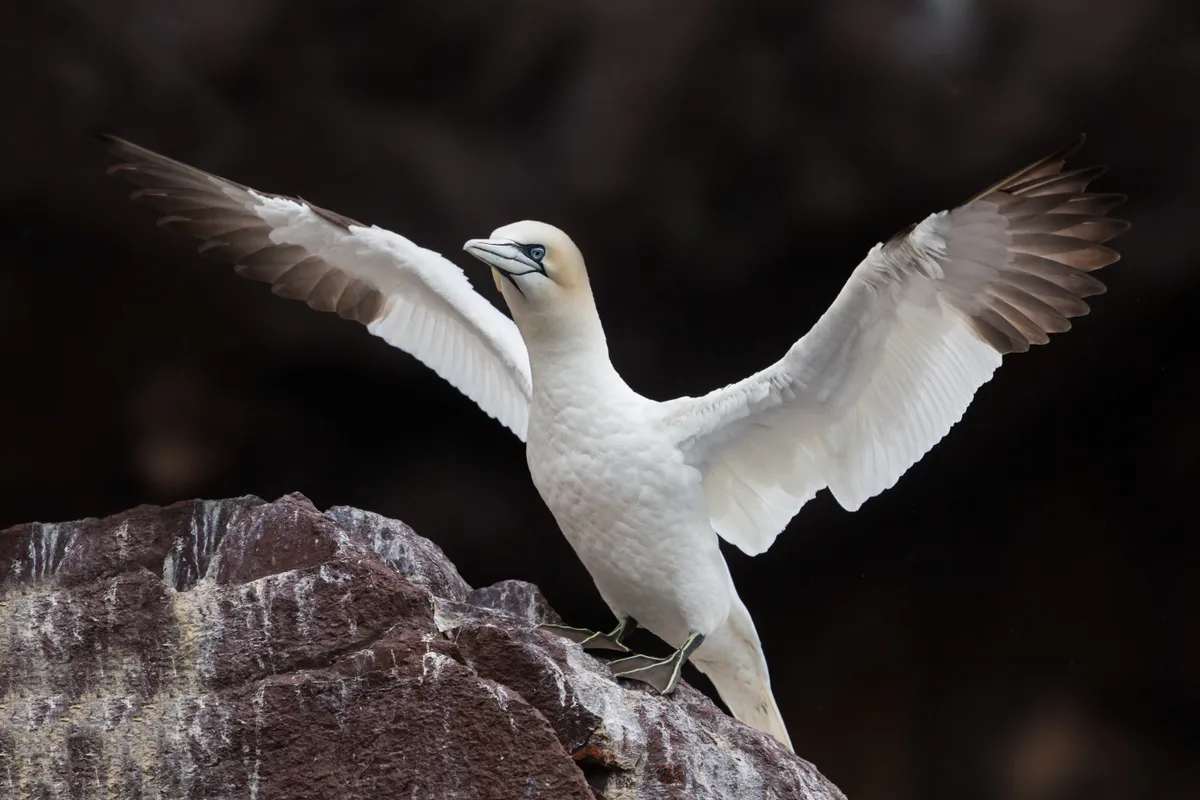
One of our largest seabirds, northern gannets are very distinctive, snowy white with a pale yellow head and black wing tips. They nest in large, smelly colonies on coastal cliffs, and are famed for their super-fast diving abilities. They circle high above the waves using their excellent sharp blue eyes to spot prey before performing their characteristic hunting dive. They can hit the water at speeds of up to 60mph and can dive as deep 72 feet.
Marianne Taylor is a birdwatcher, naturalist and the author of The Gull Next Door, published by Wild Nature Press.
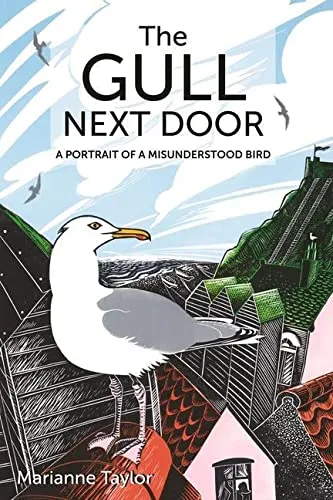
Main image: An adult herring gull. © Marianne Taylor
